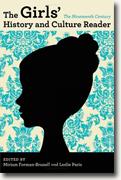The Girls' History and Culture Reader: The Nineteenth Century
Miriam Forman-Brunell and Leslie Paris, eds.
book reviews:
· general fiction
· chick lit/romance
· sci-fi/fantasy
· graphic novels
· nonfiction
· audio books
· author interviews
· children's books @
curledupkids.com
· DVD reviews @
curledupdvd.com
newsletter
win books
buy online
links
home
for authors
& publishers
for reviewers

 |
The Girls' History and Culture Reader: The Nineteenth Century Miriam Forman-Brunell and Leslie Paris, editors University of Illinois Press Paperback 328 pages December 2010 |
|
This book is a pair with another volume covering the twentieth century. The focus is on girls, from childhood to young womanhood. In The Girls' History and Culture Reader: The Nineteenth Century
There is an essay on dolls, the whys and wherefores of owning (when financially possible) and playing with these archetypal toys. Even boys were allowed to play with dolls, we learn, though they often used their playthings roughly. It was thought that by enjoying their dolls – especially sewing for them – girls were modeling the manners they would need in their later lives. Through these informative and expert essays, we are able to see how life for women progressed in an earlier time, including the element of deep friendship between women, which could be an enduring part of life even for married women. Through loving and at-times passionate letters, we see that such relationships were respectable and essential to many women, whose husbands, whether hardworking or kindhearted, often lived in an entirely different world from their spouses. Sad yet significant are the lives of working girls in the cities, children turned prostitutes at a disturbingly early age to suit the yearnings of Victorian men who idealized beautiful little children but, at the same time, longed to possess them as sexual objects. Street urchins in the 19th century quickly found that doing favors for men in back alleys, parks or hotels, alone or in well-organized gangs, kept them from starvation. Often their mothers were abandoned by husbands or boyfriends and, going out to work themselves, had no control over the lives of their children. Young working women also had to decide whether to give in to the desires of suitors or risk having no dates, no entertainment, no social or emotional life at all. Although this is a scholarly collection, it cannot fail to fascinate. Originally published on Curled Up With A Good Book at www.curledup.com. © Barbara Bamberger Scott, 2011 |
|
|
|
 Click here to learn more about this month's sponsor! |
|
| fiction · sf/f · comic books · nonfiction · audio newsletter · free book contest · buy books online review index · links · · authors & publishers reviewers |
|
| site by ELBO Computing Resources, Inc. | |
 By contrast, we have portraits of young sisters being educated at home and at school in the 19th century, in
well-to-do white families. These girls were encouraged to learn at the same pace as their brothers, up to a certain point. In early to mid adolescence, however, the focus changed, both by decree of the girls’ father and oversight of their mother, to an emphasis on womanly arts, graciousness, and the wiles needed to land a husband and keep a fine house. Thus they were forced to narrow their intellectual scope to only what would be needed to marry and run a household.
By contrast, we have portraits of young sisters being educated at home and at school in the 19th century, in
well-to-do white families. These girls were encouraged to learn at the same pace as their brothers, up to a certain point. In early to mid adolescence, however, the focus changed, both by decree of the girls’ father and oversight of their mother, to an emphasis on womanly arts, graciousness, and the wiles needed to land a husband and keep a fine house. Thus they were forced to narrow their intellectual scope to only what would be needed to marry and run a household.